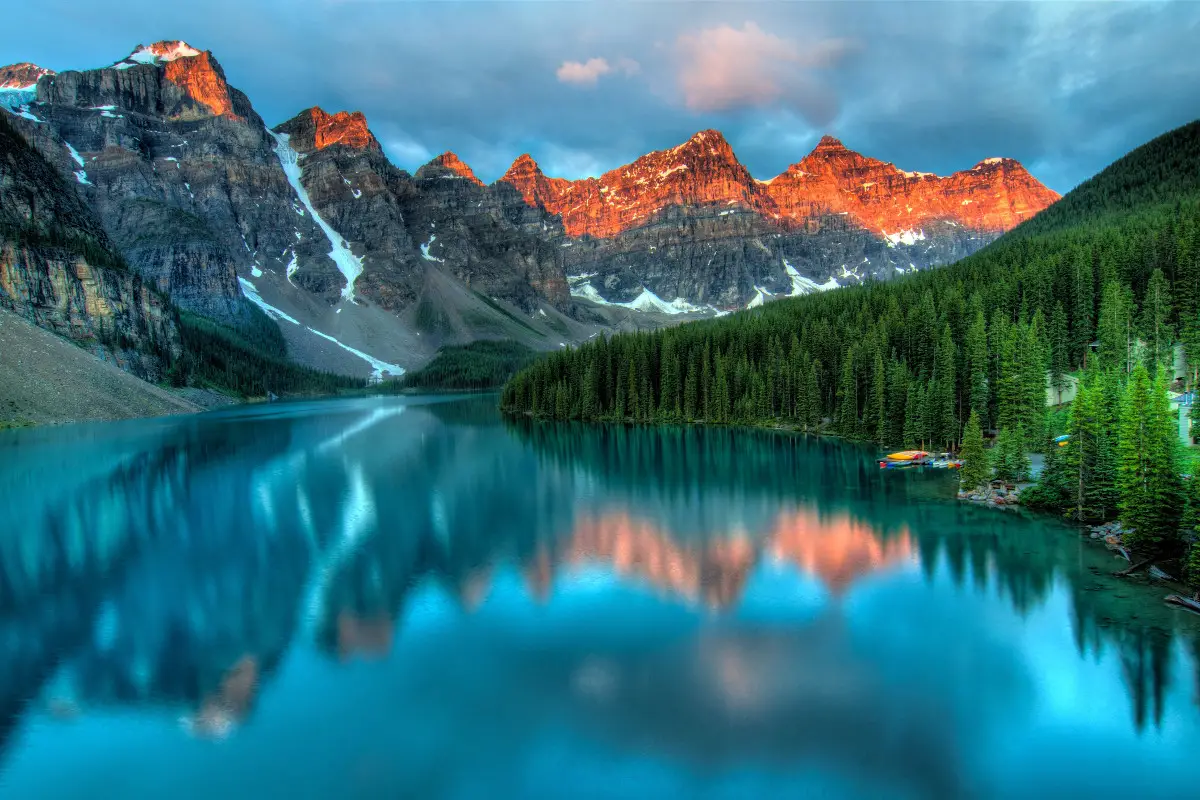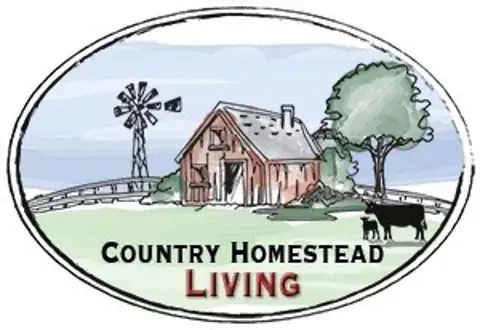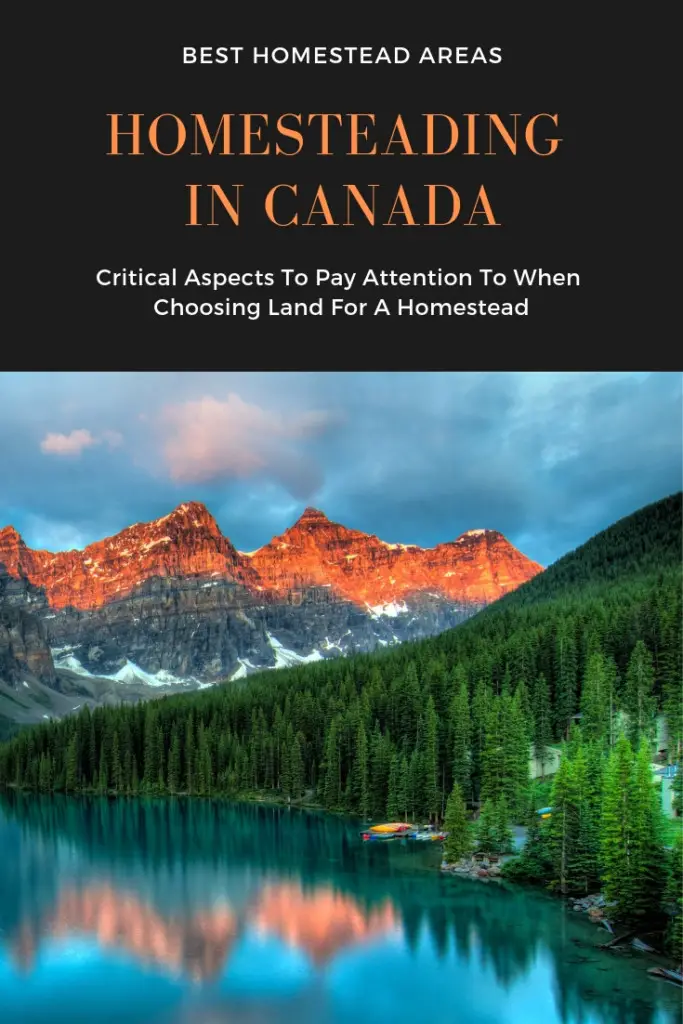Homesteading in Canada has similarities and areas similar in appearance and homestead possibilities to many of those in the U.S.
Most of the differences between Canadians and U.S. citizens come from the differences in the way each country operates.
Where are the best Homestead Areas in Canada?
The best homestead areas are: The Okanagan Valley of British Columbia; The Canadian Rockies bordering Alberta and British Columbia; The Southern portion of New Brunswick; Portions of the Maritime Island Provinces.
To successfully homestead in Canada you need to have the same critical aspects for homesteading that you need if homesteading in the U.S.
In brief those critical aspects include water, good soil, trees, access to property and a good homestead location.
More can be found in an article I wrote titled, “Homestead – Critical Aspects And Important Considerations.”
This article about the best homestead areas in Canada will start out with the main differences and similarities between Canada and the U.S.
This will allow citizens in each country to have a better understanding if they choose to look for land across their border in the other country.
A Difference In Access Terminology
In Canada Legal Access to property that is reached by crossing other privately owned land is by an Express Grant.
In the U.S. Legal Access across private property is called a Deeded Easement.
In spite of the difference in terminology the legal effect is the same.
Permission is granted for a landowner to cross someone else’s private property to access his land.
The Express Grant is registered in the Land Registry Office and is written into the title to the dominant land and the servient land.
The dominant land is the property that benefits from the express grant of an easement.
The servient land is the land that is burdened, the land over which access is allowed, under the express grant of the easement.
The Legal Description of the Express Grant in the dominant land’s title begins with the words “together with” and goes on to describe the location of that access easement granted across the private land.
The Legal Description of the Express Grant in the servient land’s title begins with the words “subject to” and goes on to describe the area of access easement across the private land that the neighbor can use to get to his land.
Differences Affecting Homestead Locations In U.S. And Canada
Canada is much less densely populated than the U.S. is.
This allows for more homesteads to be located in the southern portion of Canada than if there was a denser population there.
There are less Military Bases in Canada than in the U.S.
This means there is less problems in locating a homestead away from an area of potential collateral damage from a strike on a military base in case of a war.
The Eastern Canadian Providences of Newfoundland and Nova Scotia have little military importance other than a location to begin or end crossing the Atlantic Ocean.
They have much more areas suitable for homesteading than the Eastern States in the U.S. have.
Similarities Affecting Canadian And U.S. Homestead Locations
Many Canadian areas bordering the U.S. have the same mix of advantages or disadvantages for homesteading as the adjacent area in the U.S. has.
Canadians are very similar to Americans in many ways besides language.
They share much the same ethics, pioneering spirit, desire to live independently and to care for their families that American’s have.
Canadian lifestyle is very similar to American lifestyle.
Even large Canadian cities have many of the same problems with crime and immigration that are found in American large cities.
So homestead locations, to be safe, need to be away from large Canadian cities.
Even the French Canadians living in the providence of Quebec have more in common with Americans than they do with Frenchmen.
Differences In Canadian And U.S. Government And Laws
In theory the Canadian Government has more power and authority than the American Government has.
Like Britain, Canada has a Parliamentary system with no separation of powers between the executive and legislative branches of government.
This can lead to a more centralized and powerful national government.
One effect of this difference between Canadian and U.S. Government is that laws can change faster in Canada than in the U.S.
That said, Canadians have the same basic rights to trial by jury, representation by a lawyer and protection from searches without a warrant that Americans have.
Canada’s National Healthcare System is much more socialized than America’s Healthcare System.
This means there are more Doctor shortages in Canada than in the U.S. and access to medical specialists is more restricted in Canada than in the U.S.
Canada’s National Healthcare system is called “Medicare” but no one is forced to use the system.
It can help families achieve self-sufficiency because there is no need of health Insurance in Canada.
Canada’s medicare pays for most medical care.
The problem arises when a particular medical specialist is needed.
There can be a long wait to get an appointment or one may have to travel long distances to find the medical specialist needed.
This problem has many wealthy Canadians visiting the U.S. when they need specialized medical care.
Homesteading in Canada can be done off-the-grid.
Homesteaders in Canada can grow their own food, own their own land and generate their own electricity.
Media reports of off-grid living in Canada being against the law involve people living inside city limits who do not want to be connected to municipal utilities, not to homesteaders living out in the countryside.
As is also found in America, there are areas of Canada where there are over zealous local authorities who can cause problems.
The solution is to learn where these areas are and avoid them.
You can learn about those areas by careful internet research, research in Canadian newspapers and talking to locals in any area where you might be considering homesteading.
The Canadian Homestead Movement
There is a back-to-the-land movement in Canada just like there is in the U.S.
More and more couples are choosing to move away from the cities.
And choosing to learn how to live off-the-land by raising their own food and preserving and preparing it with traditional methods.
Since Canada is experiencing a growing crime problem, much as the one being experienced in the U.S. more Canadians are looking at homesteading as an option to live in a quieter and a safer area.
Homesteading In The Okanagan Valley And British Columbia
This is a large area in the center of British Columbia just above the U.S. border.
It is arguably the best homestead location in all of Canada.
It has plenty of lakes, fertile soil, good climate, normal growing season and forests on both sides of the valley.
The best locations would include plenty of trees and may be on the edges of the valley.
There are several small towns such as Osoyoos and Penticron and the people are friendly.
The largest town is Kelowna located on Lake Okanagan.
This area is far enough away from the Cascadia Subduction Zone lying off the coast of Vancouver Island to be safe from a potential earthquake and the predicted resultant tsunami.
The area north of Kamloops, B.C. is a good area for homesteading if there is no need of a job away from the homestead in order to survive.
As long as you stay about 50 miles away from the only Canadian Air Force base located there, the coastal area of British Columbia has several good homesteading locations.
You would want to do some research to see whether Vancouver Island is predicted to be an effective barrier to a tsunami caused from the Cascadia Subduction Zone before deciding to homestead along the southern coast of British Columbia.
Another possibility for homesteading in British Columbia is on the western edge of the Rocky Mountains above the Okanagan Valley region.
The foothills of the Western Rockies would be the place to start looking if this was the area you choose.

Homesteading In The Canadian Rockies Of Alberta
Some of the best homestead area around the Eastern Canadian Rockies are located in the foothills of the mountains on the Alberta side.
Just be sure that all the critical aspects necessary for a good productive homestead are present on the land you are considering as I share in “Homestead – Critical Aspects And Important Considerations.”
It is best to avoid areas near the popular tourist locations of Banff and Lake Louise.
These areas are beautiful and tend to have fairly expensive land prices.
The areas near Edmondton and Red Deer to the north have some good homesteading areas as long as you stay away from the military base north of Edmonton and the one near Cold Lake.
The Canadian Plains to the east of Calgary have a much drier climate with warm summers and extremely cold winters due to Arctic air masses coming down in the winter.
Winter temperatures in the Canadian Plains can be 50 below zero.
Because of the severe weather in the winter, the Canadian Plains in Alberta are not the preferred areas to homestead.
Homesteading In The Southern Portion Of New Brunswick
Southern New Brunswick is probably the best area to Homestead in Eastern Canada.
It has good farmland, areas of hills or higher ground that allow for basements under houses and low population density.
This area is close to the Atlantic which is a plus for those who like sea food or might want to add deep sea fishing to their homestead endeavors.
The biggest problems to bother a homesteader are likely to be the cold and dampness of winter and the humidity and bugs in the summer.
Homesteading In The Maritime Island Provinces
The Maritime Provinces includes New Brunswick and the Islands of Nova Scotia, Newfoundland and Prince Edward Island.
The Maritime Island Provinces are quite large and sparsely populated.
This makes the Islands of Nova Scotia, Newfoundland and Prince Edward Island with their proximity to the mainland much better places to homestead than most islands.
The Gulf Stream from the Atlantic moderates the climate here quite a lot.
Thus the Maritime’s are not as cold as the Central and Western provinces and even warmer than many locations in the State of Maine in the U.S.
The area toward the center of Nova Scotia has soil that is extremely fertile.
Prices for land in the Maritime’s are quite reasonable compared to the rest of Canada.
An additional factor, mentioned earlier, is that there is no real military value to the Maritime’s except as a location to begin or end crossing the Atlantic.
Homesteading In The Rest Of Canada
The northern portions of Canada are very bleak, remote and isolated.
They are only suited as homesteads for a few people who can stand the extreme cold and long winters.
This includes the northern portions of British Columbia, Alberta, Saskatchewan, Manitoba, Quebec and the entire regions of Labrador, Yukon and the Northwest Territories.
Quebec
Going northwest of the City of Quebec there are areas in the mountains and hills that can be homesteaded.
You will want to stay about 30 minutes away from the city of Quebec.
Thirty minutes northwest of Montreal there are also areas than can be suitable for homesteads.
Ontario
The peninsula of land between Toronto and Windsor that is surrounded by the Great Lakes is not a good area to try and homestead because of the density of population.
Once you get above Peterborough, especially to the northwest the chances of finding suitable land for homesteading improve.
Manitoba
Manitoba is basically agricultural in the southern half of the Province.
There are a lot of lakes scattered throughout this Province.
The southern portion is at the far north end of the plains called Tornado Alley in the U.S.
This portion of Manitoba averages 12-15 tornadoes a year including the strongest F5 twister in Canadian history.
Summers are hot and humid and Manitoba holds the Canadian record for the highest percentage of humidity in the nation.
If Homesteading here, it is not going to be easy to find an area with all the critical aspects needed for a homestead and a comfortable summer climate.
Saskatchewan
Saskatchewan is agricultural and mostly plains with much less water than that in Manitoba.
Forty-five percent of all grains grown in Canada are grown here.
The population is sparse and Saskatchewan holds the record for both the highest temperature in Canada, 113 degrees F and the lowest temperature in Canada, -60 degrees F.
It is possible to find forested areas where one could homestead as long as there was adequate water to be found.
However, the wide range of temperatures make this a less desirable portion of Canada to homestead.
Does Canada Still Have Free Homestead Land
The answer to that question depends on how you define the word “free.”
There is a portion of the Yukon, that Province located between British Columbia and Alaska where there are still remnants of the old fashioned homesteading.
But to participate you must have lived in the Yukon for at least a year.
Becoming a “sourdough” to the locals.
Plus you must show that you have a knowledge of farming by filling out a Farm Development Plan that is 9 pages long.
Question four on this 9 page development plan says; “Please explain how and where you plan to market your farm products so that your operation will achieve financial viability.”
This program, most recently updated in 2006, is called the Agricultural Lands Program.
It has a stated mission to “make new land available for agriculture.”
No where in the program do you find the word “homestead.”
Once the Farm Development Plan is accepted, the wannabe landowners can sign up for a plot in an already surveyed agricultural land subdivision.
Or look through government maps to locate another piece of land.
This program is headquartered in Whitehorse, Yukon Territory but the nearest land available is about 100 km, (62 miles) outside of Whitehorse.
Once a plot of land is chosen, the Yukon Agriculture Branch determines the lands assessed valuation.
The applicant must make enough improvement on the land to equal the assessed valuation.
If the property is assessed at $100,000 the homesteader has to make $100,000 worth of improvement before receiving title to the “free land.”
The improvements can be fencing, building roads or a house and there has to be “two thirds of 80% of the land cleared, developed and in production.”
The practical application of this is that the land has to have viable crops growing on that large portion of it before the title passes from the government to the homesteader.
As can be seen, this is a multiple years process and in the end it is arguable that you are getting “free land.”
Some of the comments collected over several years from those who successfully received their “free land” include;
“Your chances of doing it as Joe Blow off the street are really slim.”
“There’s nothing free about it all. If you’ve got to pay $100,000 for $100,000 of assessed land, that’s not free.”
“As long as you’ve shown it green … you get title to it, and then you’re not compelled to farm.”
There is the concept of “sweat equity.” It can take up to 20 years to develop the land and receive a title to it.
How much is that person’s hard work, the “blood, sweat and tears” worth?
Is it only worth $5,000 a year if the land finally titled to the homesteader was assessed at $100,000?
For that matter, if the work was completed in only 10 years and the property was assessed at $100,000 is the homesteader’s hard work only worth $10,000 a year?
At some point in time, the Yukon will probably stop this program or the available land will run out.
Maybe another province will have a similar program in the future?
Does Canada still have free homestead land?
Each person has to answer that question for themselves.
Is it worth moving a family that far north and putting up with the cold and problems associated with clearing land, making improvements and working to obtain “free land?”
That is another question each potential neo-homesteader has to answer for themselves also.
Related Questions
Can foreigners buy land in Canada?
Yes they can, but there are different restrictions than on permanent Canadian citizens.
It is common for foreigners to have to put 35% down payment.
Several provinces have maximum acreage limits which can be 5, 10 or 20 total acres.
Is there free land in Canada?
Depends on what you call free.
A portion of the Yukon Territory has a land program open to those who have lived there for at least 1 year.
But it is not really free.
If you are granted a piece of land that is valued at $100,000.00 you must make $100,000.00 worth of improvements on it to get the land.
Where is the best agricultural land in Canada?
The Okanagan Valley, portions of the Maritime Islands and northwest of the City of Quebec are the best agricultural areas in Canada to homestead in.


